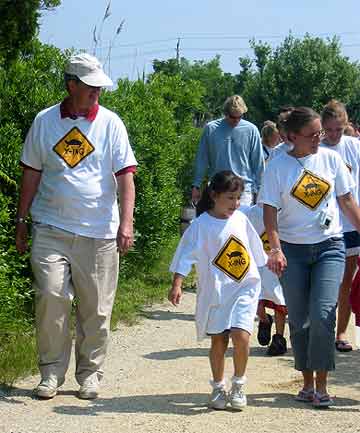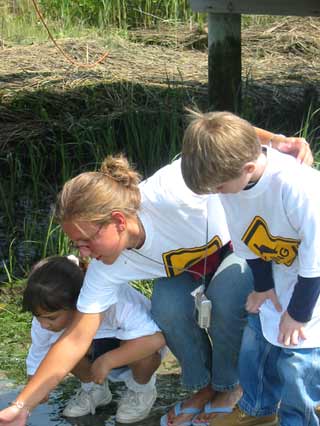|
Into the Great Wide Open

By Laura Schoenle
 |


Kindergartners parade down to the marsh.
 |
|
On Tuesday, June 9, the Avalon/Stone Harbor combined kindergarten class sent 20 diamondback terrapins back home to the salt marshes surrounding the Wetlands Institute. Adorned appropriately in “Turtle Crossing” T-shirts, the kindergartners paraded down to the edge of the marsh and gave the 2–3 inch terrapins a push towards freedom. Throughout the year, the children (with a little help from their teachers, Roberta Dean and Sue Jones) baked turtle-shaped cookies to raise money for the Wetlands Institute. Accompanying their contribution was a matching donation from Sturdy Savings Bank to help support the Terrapin Conservation Project. Mrs. Dean's kindergartners have been participating in the Terrapin Conservation Project since 1992, longer than any other school group.
The Terrapin Conservation Project facilitates the release of about 200 terrapins each year. Each release is an opportunity to educate local school children about conservation and the declining population of diamondback terrapins in the surrounding salt marshes. Media coverage of these releases publicizes the plight of terrapins to a much wider audience.


Ashley and kindergartners release a headstarter.
 |
|
 |
Preparation to release the "headstarter" terrapins begins with the retrieval of eggs from road-killed terrapins found during the nesting season. After a seven-week incubation period, as many as 50 percent of the recovered eggs hatch into quarter-sized terrapins, which we refer to as “seagull potato chips” for their susceptibility to predation. Until they are large enough to face the dangers of the marsh, the hatchlings are raised on a “turtle farm” located at the science laboratories of Richard Stockton College.
As a final step before their release, the terrapins are injected with a microchip, an identification device unique to each terrapin. All terrapins captured near the Wetlands Institute or found dead are checked for the microchip as a part of several ongoing studies, including population estimates and nest site fidelity.
|